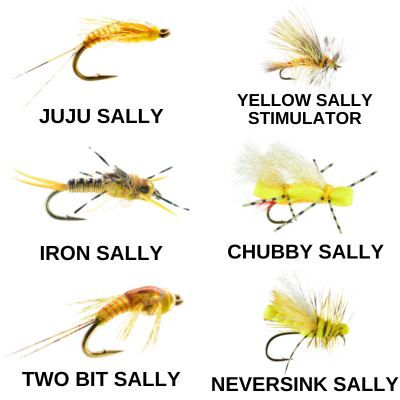Bug of the Month: Yellow Sally Stonefly
ABOUT THE YELLOW SALLY
The yellow sally, or yellow stonefly (Isoperla species), is a charming little insect that flies under the radar for most folks. Found near clean, cold streams, these insects are part of the stonefly family and serve as a crucial food source for trout. They’re named after their distinct yellow coloration and are often seen skittering on rocks or dancing over the water. These bugs have a knack for blending in, but they play a big role in the ecosystem, making them a favorite among freshwater biologists and anglers alike.

Yellow sallies are small to medium-sized insects (fly sizes 14-18) belonging to the stonefly family (Perlidae). They are characterized by their bright yellow or yellowish-green coloration, which varies slightly depending on the species and location. Their presence in a stream or river is often an indicator of good water quality, as they are sensitive to pollution and habitat degradation. These stoneflies are not only important trout food sources, but also play a vital role in maintaining healthy aquatic ecosystems.

In terms of biology, yellow sallies undergo incomplete metamorphosis, meaning they have three life stages: egg, nymph, and adult. In their nymph stage, yellow sallies typically inhabit clean, fast-flowing streams and rivers with rocky bottoms, where they spend their time clinging to rocks and feeding on algae and detritus.

As adults, yellow sallies emerge from the water by crawling onto rocks and vegetation to molt, during the warmer summer months, and are known for their fluttering flight patterns. They are active during the daytime and can be found near the water where they lay their eggs to start the life cycle over again.

FISH THE YELLOW SALLY
FLY SELECTION
Pay close attention to the size of the yellow sallies in the area you’re fishing. Effective patterns usually range in size from 14-18. They are often much smaller than the stoneflies we typically target. For nymphs, some of our favorite patterns include the Iron Sally, Two Bit sally, Juju Sally, and the Sweetmeat Sally. For dries, we love the Yellow Sally Stimulator, Chubby Sally, Neversink Sally, and even a light Elk Hair Caddis.

PRESENTATION
Yellow sallies are often seen fluttering near the water surface or landing on rocks. Anglers should present their flies with delicate casts to imitate this natural behavior. Use short, accurate casts to place the fly close to feeding trout.
Stoneflies like yellow sallies often drift passively on the water surface, making a drag-free drift crucial. High-stick or mend often to achieve a natural drift, but don’t be afraid to throw in an occasional twitch or skate.
When fish aren’t rising, fish your yellow sally nymph right on the bottom of the water column, closest to your split shot, and use small or wool indicators to detect subtle strikes. They require well-oxygenated water, so look for them in riffles and fast-moving sections of streams.

TIE THE YELLOW SALLY
Color is important to consider when tying any yellow sally fly. Often patterns such as a two bit hooker or elk hair caddis can be made into excellent yellow sally imitations simply by using pale yellow with a bit of red. When tying nymphs, including a bead (or two!) can be a huge help in getting your fly to the very bottom of the water column, where yellow sallies are naturally more present.
Check out the video below to tie Neil’s Yellow Sally with Covey Guide and Tying Master Neil Luehring.

Neil is one great fly tyer. I haved learned so much from his tying videos since finding them on Utube. I have been tying since about 1980. Anyway tell him thanks for the instruction.